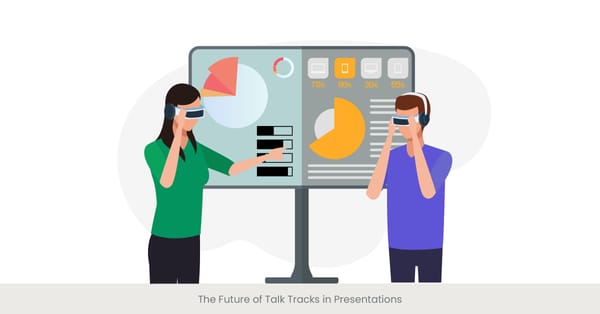
Essence of Talk Tracks in Communication
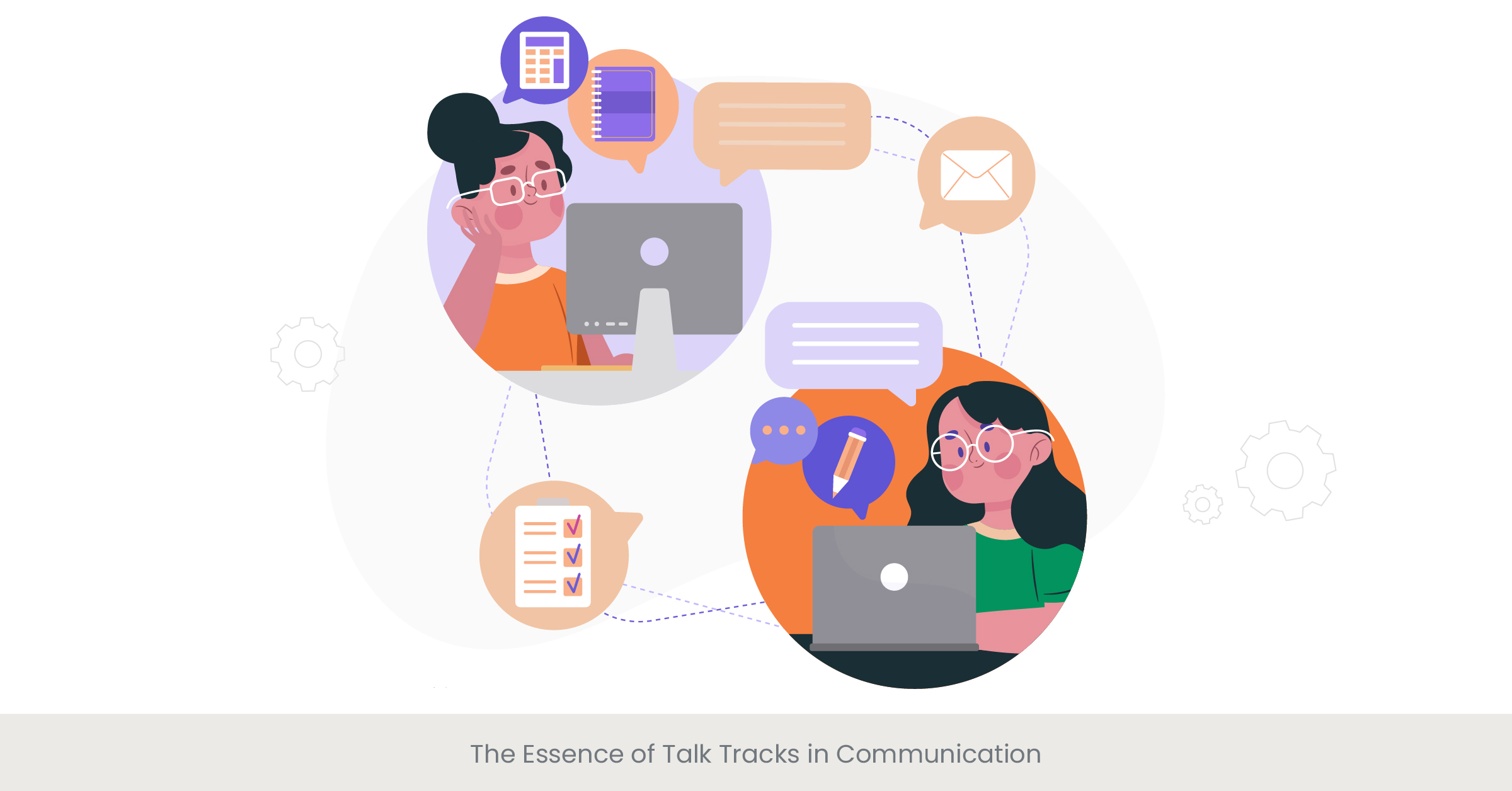
Harnessing the Power of Words in Presentation Design
Talk tracks form the backbone of effective communication, especially within the realm of presentation design. At their core, talk tracks are structured outlines or scripts that guide speakers through their presentations, ensuring they convey their message clearly and effectively. This approach not only aids in delivering content in a more engaging manner but also in maintaining the focus of both the speaker and the audience. The essence of talk tracks lies in their ability to transform complex ideas into understandable and relatable narratives, thereby enhancing the overall impact of the communication process.
A Historical Perspective: Tracing the Roots of Talk Tracks
The concept of talk tracks is not a modern invention but has historical roots in the art of rhetoric and storytelling. From ancient orators to contemporary public speakers, the fundamental principles of talk tracks have been employed to captivate and persuade audiences. Over the years, the evolution of media and technology has further shaped the development and application of talk tracks, adapting them to fit various formats, from traditional speeches to digital presentations. This historical evolution underscores the enduring importance of structured communication in achieving effective engagement.
Real-World Applications: Talk Tracks in Action
In today's fast-paced professional settings, talk tracks are more relevant than ever. Whether it's a sales pitch, a corporate presentation, or an educational lecture, talk tracks help speakers navigate their content systematically, ensuring key points are highlighted and the intended message is delivered cohesively. For instance, in a sales team meeting, a well-crafted talk track can ensure that all representatives share a consistent and compelling message about a product, thereby enhancing team collaboration and communication effectiveness. Such real-world applications highlight the practical utility of talk tracks across various contexts.
Grounding in Research: The Scientific Validation
Research and studies on communication and psychology provide valuable insights into the effectiveness of talk tracks. For example, a study published in the "Journal of Communication" highlights how structured communication strategies, akin to talk tracks, significantly improve audience retention and engagement. Further, metrics like audience feedback, engagement rates, and recall tests serve as quantitative measures to evaluate the success of talk tracks in real-time presentations. These sources not only validate the significance of talk tracks but also encourage their thoughtful development and application in communication strategies.
Historical Evolution of Talk Tracks

From Oratory to Online: The Journey of Structured Communication
The historical evolution of talk tracks reflects the broader narrative of human communication, from ancient rhetoric to modern digital presentations. Initially, talk tracks found their roots in the structured methods of speech delivery employed by orators in ancient civilizations, where the power of the spoken word was paramount. These early foundations laid the groundwork for understanding how structured communication can influence and persuade audiences. As societies evolved, so did the methods of communication, with each era adapting talk tracks to suit its unique needs and technologies, from the written scripts of medieval scholars to the teleprompted speeches of the 20th century.
The Digital Age: A New Chapter for Talk Tracks
The advent of the digital age marked a significant turning point for talk tracks. With the rise of the internet, social media platforms, and online meetings, talk tracks have transitioned from purely oral traditions to encompass digital and multimedia presentations. This transition has not only expanded the reach and accessibility of talk tracks but also introduced new challenges and opportunities in presentation design. Today, talk tracks must captivate audiences not just in boardrooms but across the globe, necessitating a blend of traditional eloquence and digital engagement.
Illuminating Examples: The Evolution in Practice
The evolution of talk tracks is evident in the transformation of public speaking and presentation methods over the centuries. For instance, the eloquent, carefully structured speeches of ancient orators like Cicero contrast with the dynamic, multimedia presentations of contemporary TED speakers. Yet, both rely on the fundamental principles of talk tracks: clarity, engagement, and persuasion. Another example can be seen in the corporate world, where the transition from in-person sales pitches to virtual presentations has necessitated the adaptation of talk tracks to maintain effectiveness in communication.
Persuasion training presentations are designed to equip speakers with techniques to influence and convince their audience. These presentations focus on understanding psychological triggers and effective communication strategies. By mastering persuasion, presenters can foster trust, encourage action, and inspire audiences to take the desired steps following the presentation.
Scholarly Perspectives: Backed by Research
Research into the evolution of communication practices provides insight into the adaptation and persistence of talk tracks. Studies in the fields of rhetoric, communication, and media studies have traced the transformation of talk tracks through historical contexts, emphasizing their adaptability and enduring relevance. For example, a study in the "Journal of Business Communication" explores how talk tracks have evolved to meet the demands of digital communication, highlighting their critical role in effective communication across various media. These studies not only enrich our understanding of the history of talk tracks but also underscore their significance in both past and present communication landscapes.
Key Components of Effective Talk Tracks
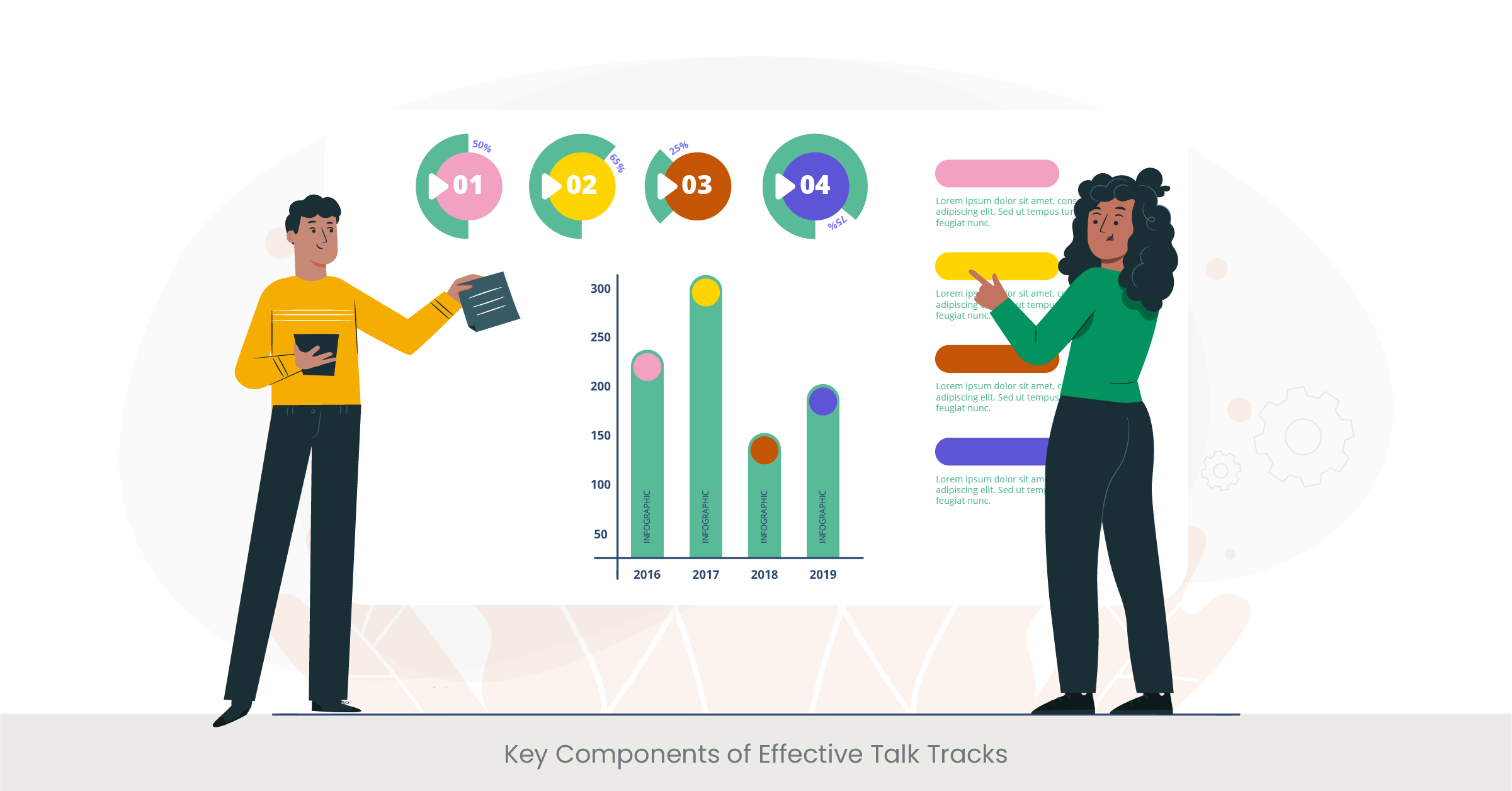
Crafting Clarity and Cohesion in Communication
The key components of effective talk tracks lie at the intersection of clarity, coherence, and engagement. An effective talk track is meticulously structured to ensure that every word and sentence serves a purpose, guiding the audience through the presentation without confusion. It begins with a clear introduction, setting the stage for what the audience can expect. This is followed by the body, where the core message is broken down into digestible segments, each smoothly transitioning to the next. Finally, a compelling conclusion ties the message together, reinforcing the key takeaways. This structure is pivotal in achieving the ultimate goal of any communication effort: to convey a message in a manner that is both understandable and memorable.
A Historical Perspective on Effective Talk Track Structures
The evolution of talk track structures reflects broader trends in communication strategies and audience expectations. Historically, the art of rhetoric emphasized the importance of a well-organized speech, with Aristotle's modes of persuasion (ethos, pathos, logos) informing the development of effective communication. In modern times, the principles of these ancient strategies are still applied but are tailored to fit contemporary presentation formats and audiences. For example, the integration of visual aids and storytelling techniques in today's presentations echoes the ancient practice of painting vivid images through words, adapted for a digital era.
Effective talk tracks for events ensure that key messages resonate with the audience, whether it’s for corporate, educational, or entertainment purposes. These tracks are tailored to the event's objectives and audience, ensuring the delivery is impactful. Well-thought-out talk tracks maintain the audience’s attention and drive meaningful interactions.
Real-World Efficacy: Talk Tracks in Action
Effective talk tracks are not confined to theoretical discussions but are implemented in various professional and casual settings. For instance, in a business presentation, a well-crafted talk track can make all the difference in persuading potential investors or partners. It ensures that the presenter communicates the business value proposition clearly, addresses anticipated questions, and responds to feedback on the spot. Similarly, in educational settings, teachers use talk tracks to structure lessons, making complex subjects accessible and engaging for students. These examples underscore the practical significance of having a well-structured talk track in enhancing the efficacy of communication.
Presentation talk tracks guide the flow of a presentation, ensuring clarity and focus. They help presenters stay on topic while delivering key messages effectively. A well-crafted talk track enhances audience engagement, making the content relatable and memorable. This structured approach is crucial for successful communication in any setting.
Interactive talk tracks engage the audience by inviting them to participate in the conversation. This could involve asking questions, using polls, or incorporating feedback loops. These tracks create a dynamic experience, allowing presenters to adjust their delivery based on the audience’s input, making the session more engaging and memorable.
Check Out Our Blog for More Tips on Effective Presentations!
Evidence-Based Success: The Metrics of Talk Tracks
The effectiveness of talk tracks is not merely anecdotal; it is supported by a wealth of research and data. Studies in communication and education have shown that structured presentations significantly improve retention and comprehension among audiences. For example, a study published in the "Journal of Educational Psychology" found that lectures organized around clear, coherent talk tracks resulted in higher student achievement compared to less structured presentations. Furthermore, feedback mechanisms such as audience surveys and engagement metrics offer tangible evidence of a talk track's impact, providing valuable insights for continuous improvement. These research findings and data-driven metrics affirm the critical role of key components in developing successful talk tracks.
Role of Talk Tracks in Professional Settings
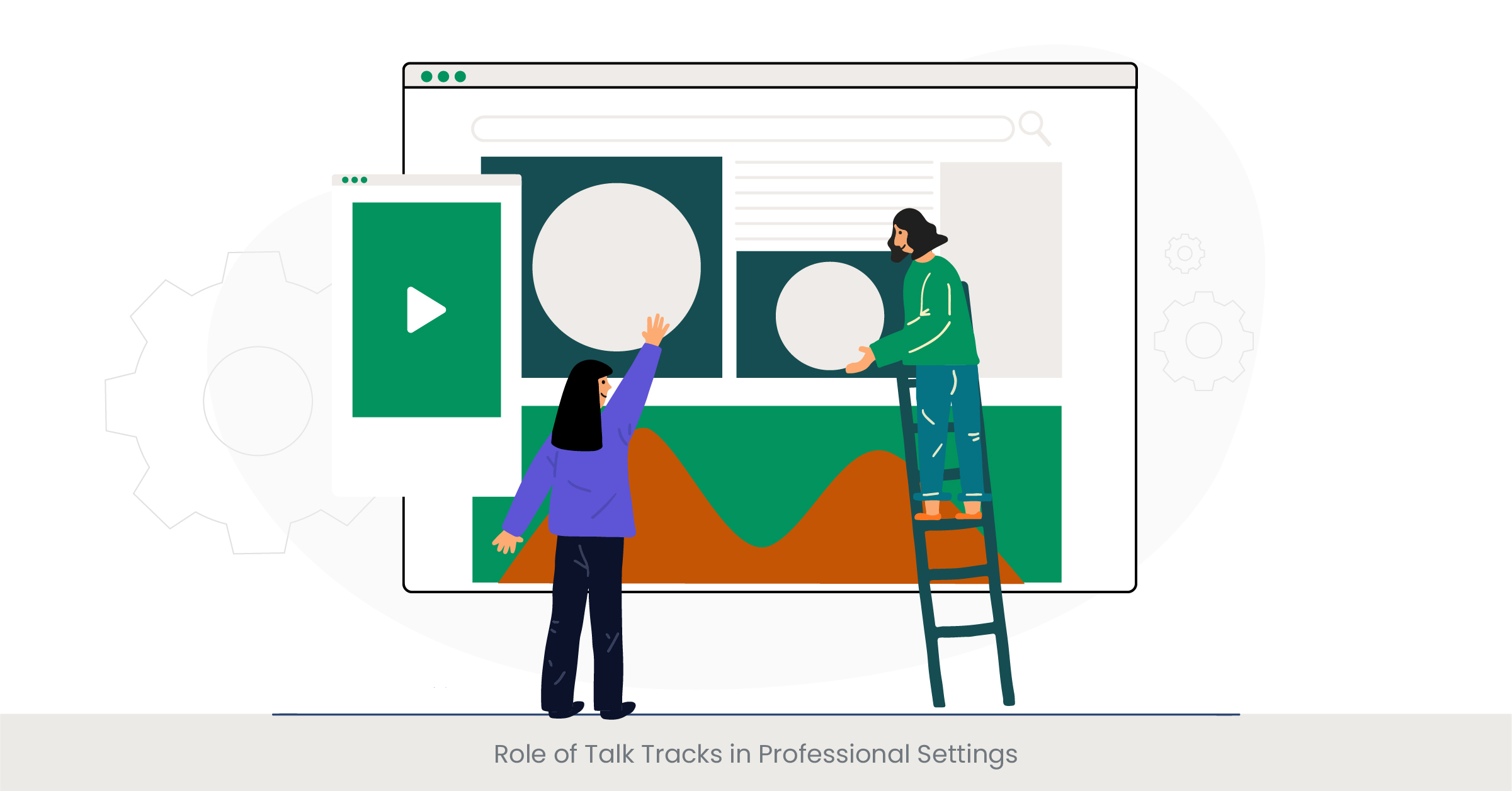
Navigating the Professional Landscape with Precision
In the dynamic realm of professional communication, the role of talk tracks cannot be overstated. These carefully crafted narratives serve as a roadmap for delivering presentations, pitches, and meetings with confidence and clarity. The strategic use of talk tracks enables professionals to articulate their ideas, proposals, and strategies in a manner that is both persuasive and coherent. This becomes particularly crucial in high-stakes situations, such as pitching to potential investors, delivering quarterly reports to stakeholders, or leading team meetings. By ensuring that key messages are conveyed effectively, talk tracks empower professionals to achieve their communication goals and foster positive outcomes.
Historical Context and Evolution in Professional Environments
The significance of talk tracks in professional settings has evolved alongside changes in the business landscape and communication technologies. Historically, the art of persuasive speaking was essential for leaders and salespeople who relied on the power of oration to influence decisions and drive business. Today, with the advent of digital communication tools and global business operations, the complexity of professional communication has increased. Despite these changes, the fundamental role of talk tracks in structuring and delivering effective messages remains constant. This historical continuity highlights the adaptability of talk tracks to various professional contexts and their enduring value in effective communication.
Illustrative Examples: The Impact of Talk Tracks Across Industries
The application of talk tracks spans a wide range of professional settings, each with its unique challenges, concerns and opportunities. In the sales industry, for example, a well-defined talk track can significantly enhance the effectiveness of a sales pitch, leading to increased conversion rates and customer engagement. Similarly, in corporate leadership, executives utilize talk tracks to articulate vision, strategy, and expectations to their teams, ensuring alignment and motivation. These examples underscore the versatile role of talk tracks in enhancing professional communication across different sectors, from healthcare to technology and beyond.
Validating Success: Research and Metrics in Professional Communication
The efficacy of talk tracks in professional settings is further validated by research and performance metrics. Studies in business communication have demonstrated that structured, coherent presentations lead to better audience understanding, engagement, and persuasion. For instance, research published in the "Harvard Business Review" indicates that executives who employ clear, structured talk tracks in their communication are more likely to secure investments, forge partnerships, and lead successful teams. Moreover, performance metrics such as deal closure rates, employee satisfaction scores, and audience feedback serve as tangible indicators of the success of talk tracks in achieving professional communication objectives. These insights not only reaffirm the importance of talk tracks in professional settings but also provide a framework for continuous improvement and adaptation to emerging communication challenges.
Presenters' talk track development involves the careful crafting of a script or outline that guides the speaker’s delivery. It’s a vital step in preparation that ensures the speaker communicates effectively. With well-developed talk tracks, presenters can maintain their confidence, stay on message, and adapt to the audience’s needs for a smooth presentation.
Explore Our Case Studies to See Real Results in Action
Differentiating Between Talk Tracks, Scripts, and Ad-Libs
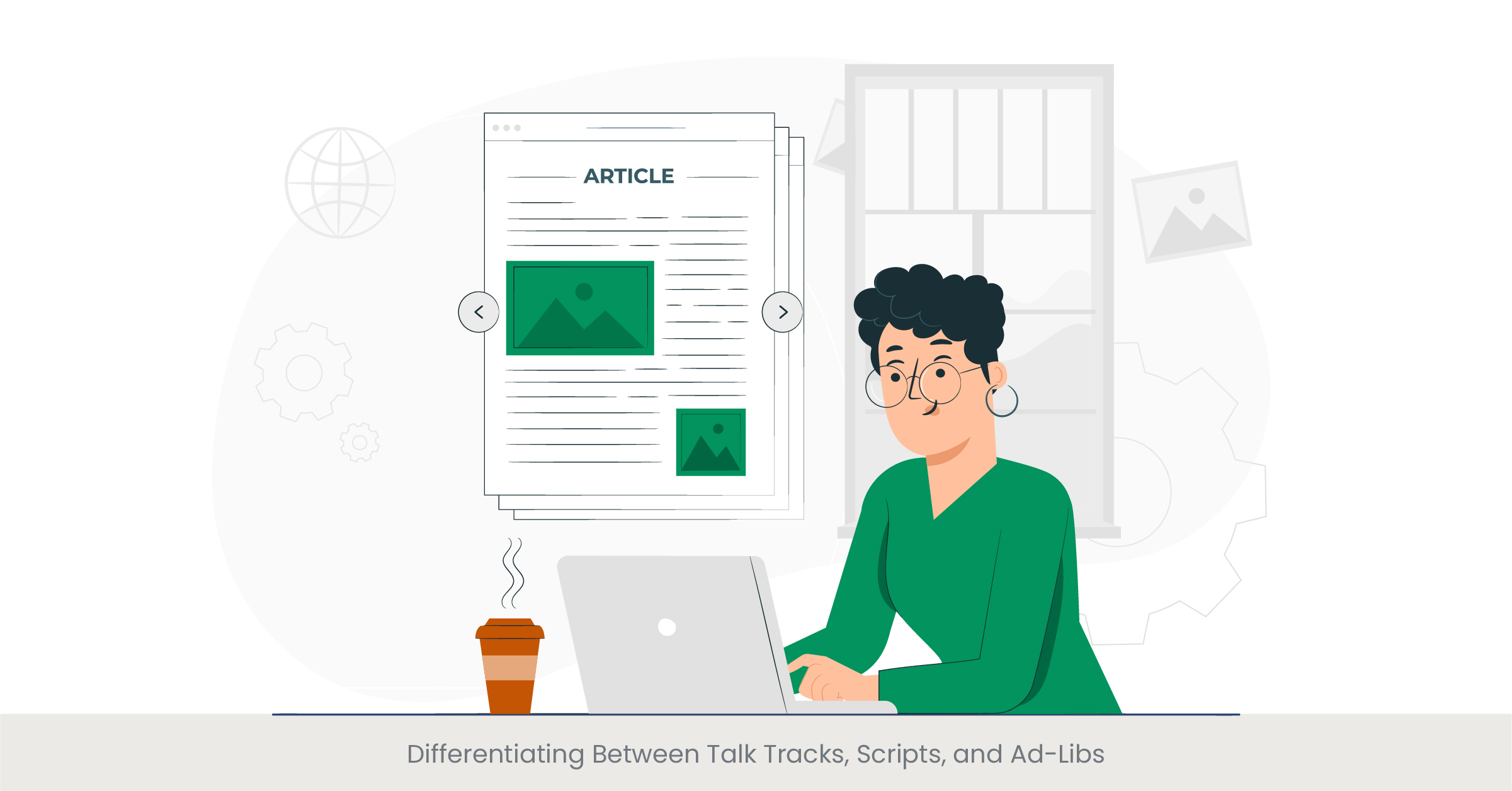
Clarifying Communication Strategies
Understanding the distinction between talk tracks, scripts, and ad-libs is crucial for mastering the art of presentation design and effective communication. Talk tracks serve as a flexible framework, guiding the flow of presentation while allowing room for personalization and adaptation to audience feedback. Scripts, on the other hand, are precise, word-for-word manuscripts that leave little room for deviation, ensuring consistency and control over the message delivered. Ad-libs represent the opposite end of the spectrum, encouraging spontaneous, off-the-cuff remarks that can add personality and authenticity but risk derailing the focus of the presentation. Each approach has its unique advantages and applications, making it essential to choose the right strategy based on the context and objectives of the communication.
Tracing the Origins and Evolution of Structured Speaking
The origins of these communication strategies can be traced back to ancient public speaking practices, where orators relied on memory and improvisation to engage their audiences. Over centuries, as societies evolved and new forms of media emerged, the balance between scripted speeches, spoken words, and spontaneous dialogue shifted. In professional settings today, the choice between using a talk track, script, or ad-lib depends on various factors, including the nature of the event, the speaker's comfort level, and the desired impact on the audience. The evolution of these strategies reflects a broader understanding of the dynamics of effective communication, emphasizing the importance of adaptability and audience engagement.
Real-World Applications: Strategy in Action
In practice, the choice between talk tracks, scripts, and ad-libs can significantly impact the effectiveness of communication. For instance, in a formal business presentation, a script might be preferred to ensure that all critical points are covered precisely, leaving no room for error. In contrast, a talk track might be more suitable for interactive workshops or seminars, where engaging the audience and responding to their cues is crucial. Ad-libs, while risky, can be effective in informal settings or when a speaker wishes to connect on a more personal level, adding humor or anecdotal insights to humanize the presentation. These strategies, when employed judiciously, can greatly enhance the quality and impact of communication across various contexts.
Insights from Research: Evaluating Communication Strategies
Research in communication studies offers insights into the effectiveness of talk tracks, scripts, and ad-libs. Studies have shown that while scripts can enhance message consistency, they may also inhibit speaker spontaneity and audience engagement. Conversely, ad-libs can boost engagement but at the risk of losing message coherence. Talk tracks strike a balance, providing a structured yet flexible approach that can adapt to the audience's dynamics. For example, a study published in the "Journal of Communication Management" highlights how executives using talk tracks can more often communicate effectively and tailor their message to their audience, resulting in higher engagement and retention rates. This research underscores the importance of selecting the appropriate communication strategy to maximize the effectiveness of the presentation.
The Science of Attention: How Talk Tracks Capture and Hold Interest

Engaging Minds in a World of Distractions
In the digital age, where distractions abound, capturing and maintaining an audience's attention during presentations has become a formidable challenge. This is where the science of attention plays a pivotal role, and talk tracks, with their strategic design, become invaluable tools. By leveraging principles from cognitive psychology and communication theory, effective talk tracks are crafted to hook the audience's interest from the outset and sustain it throughout the presentation. Key to this process is understanding how people process information, what engages them emotionally and intellectually, and how to structure a talk to resonate with those dynamics.
A Look Back: The Evolution of Attention-Capturing Techniques
The techniques used in talk tracks to capture and hold attention have evolved significantly over time, informed by advancements in our understanding of human psychology and communication practices. Historically, orators relied on rhetorical devices like storytelling, repetition, and strategic pauses to engage listeners. Today, these age-old techniques are supplemented with multimedia elements, interactive content, and data visualization, all aimed at enhancing audience engagement. This evolution reflects a growing recognition of the diverse ways in which people learn and retain information, as well as the increasing competition for their attention.
In Practice: Talk Tracks That Captivate
Real-world examples of talk tracks that effectively capture and hold interest often feature a blend of storytelling, clear and relatable messaging, and interactive elements. For instance, TED Talks are renowned for their compelling presentation design, which frequently employs personal anecdotes, thought-provoking questions, and visual aids to engage viewers. Similarly, in professional settings, sales presentations that use talk tracks to weave product features into relatable customer stories can significantly increase audience engagement and retention. These examples highlight the practical application of attention-capturing techniques in talk tracks, demonstrating their effectiveness across various contexts.
Validating Through Research: The Metrics of Engagement
The impact of talk tracks on audience engagement and retention is supported by a body of research. Studies in educational psychology, for example, have shown that presentations that employ storytelling and visual aids—key components of effective talk tracks—result in higher levels of audience attention and information recall. Moreover, metrics such as audience feedback, engagement rates, and post-presentation surveys offer quantitative evidence of the effectiveness of these strategies. For example, research published in the "International Journal of Business Communication" demonstrates that presentations utilizing structured talk tracks with engagement techniques significantly outperform those that do not. This research underscores the importance of scientifically informed talk tracks in capturing and sustaining audience attention in the face of increasing distractions.
Establishing Objectives: The First Step in Talk Track Development
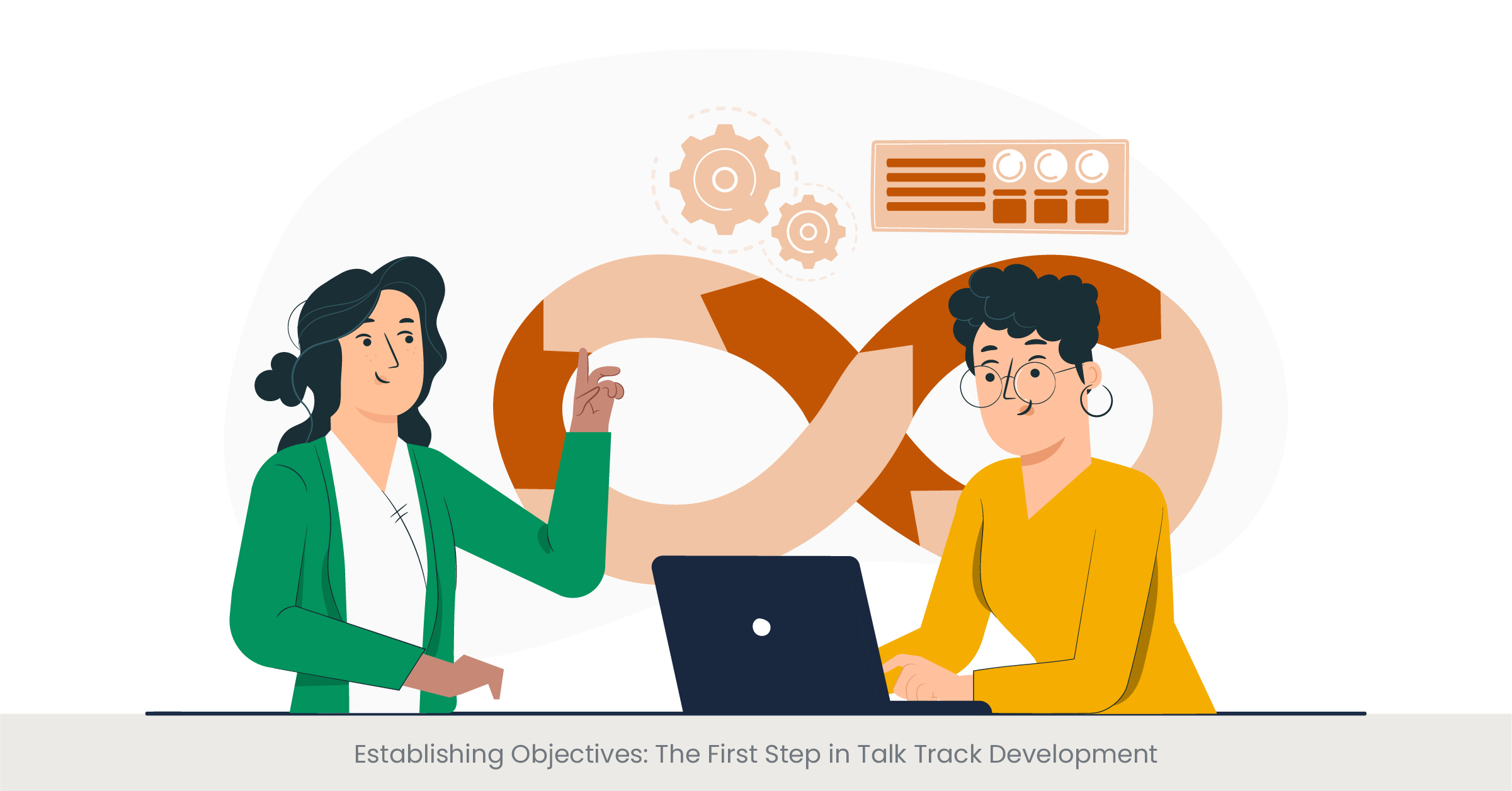
Setting the Stage for Impactful Communication
The development of an effective talk track begins with a clear understanding of the objectives behind the communication. This foundational step ensures that the talk track is purposefully aligned with the desired outcomes, whether it's to inform, persuade, inspire, or educate the audience. By establishing objectives early on, speakers can tailor their message, choose the appropriate structure, and select content that resonates with their audience's needs and expectations. This strategic approach not only enhances the coherence and relevance of the talk but also significantly increases the likelihood of achieving the intended impact.
A Historical Perspective on Communication Objectives
The importance of setting objectives and communicating them in communication is a concept that has evolved over centuries. From Aristotle's emphasis on ethos, pathos, and logos as the core objectives of persuasive speaking to modern marketing theories that outline specific goals for consumer engagement, the idea that effective communication starts with clear objectives has remained constant. This historical continuum reflects the universal understanding that purpose-driven communication is more effective, whether in ancient public forums or today's digital platforms.
Real-World Application: Objectives in Action
In the professional sphere, the practice of establishing objectives for talk tracks is evident in various contexts. For example, a marketing team developing a product launch presentation will set specific objectives related to audience awareness, interest, and action. Similarly, a teacher planning a lesson may aim to achieve objectives related to student understanding, engagement, and retention. These scenarios underscore the practical significance of having well-defined objectives as the foundation of any talk track, ensuring that the communication is focused and effective.
Research Insights: The Power of Purposeful Communication
The efficacy of setting clear objectives in talk track development is supported by extensive research in communication and educational theory. Studies have demonstrated that presentations designed with specific goals in mind are more likely to engage the audience and achieve desired outcomes. For instance, a study in the "Journal of Marketing Education" highlights how presentations with clear educational objectives result in higher levels of student engagement and learning outcomes. Furthermore, metrics such as audience feedback, engagement rates, and goal achievement rates provide tangible evidence of the success of objective-driven talk tracks. This body of research reinforces the critical role of establishing objectives in crafting effective talk tracks that resonate with both the sender and audience and fulfill the speaker's goals.
Need Expert Help? Contact Us Today for Personalized Solutions!
Audience Analysis: Tailoring Your Approach

Crafting Messages that Resonate
At the heart of effective talk track development lies a thorough understanding of the audience. Audience analysis is a crucial step that enables speakers to tailor their approach, ensuring that the content, tone, and delivery method align with the audience's interests, knowledge level, and expectations. This targeted approach not only enhances the relevance and impact of the message but also fosters a deeper connection between the speaker and the audience. By considering factors such as demographic characteristics, cultural backgrounds, and psychological predispositions, speakers can design talk tracks that truly resonate with their listeners, thereby maximizing engagement and retention.
Historical Context: The Evolution of Audience-Centric Communication
The concept of audience analysis is not new but has been a cornerstone of effective communication strategies throughout history. From the rhetorical theories of ancient Greece, which emphasized the importance of knowing one's audience, to modern marketing and public relations practices that utilize data analytics to understand consumer behavior, the focus on the audience has been paramount. This evolution underscores the shift towards more personalized, audience-centric communication methods, reflecting an understanding that the key to effective communication lies in the speaker's ability to address the specific needs and interests of their audience.
Practical Applications: Tailoring Talk Tracks for Diverse Audiences
In today's globalized world, the ability to adapt talk tracks for diverse audiences is more important than ever. For instance, a business executive presenting to international partners must consider cultural nuances and language barriers in their talk track. Similarly, educators must adapt their teaching methods and content to cater to the varied learning styles and backgrounds of their students. These examples highlight the critical role of audience analysis in developing talk tracks that are not only informative but also engaging and inclusive, thereby ensuring that the message is effectively communicated across different contexts.
Research and Metrics: Validating Audience-Centric Approaches
The effectiveness of audience-centric talk tracks is supported by research across fields such as communication, psychology, and education. Studies have shown that messages tailored to the audience's characteristics and preferences are more likely to capture attention, facilitate understanding, and inspire action. For example, research published in the "International Journal of Business Communication" demonstrates that presentations tailored to the audience's level of knowledge and interest result in higher engagement and satisfaction. Additionally, metrics such as audience feedback, participation rates, and post-presentation surveys serve as valuable indicators of the success of audience-centric talk tracks, further emphasizing the importance of a tailored approach in achieving communication objectives.
Common Mistakes to Avoid in Talk Track Preparation

Navigating Pitfalls for Clearer Communication
Effective talk track preparation is a meticulous process that, when done correctly, greatly enhances the quality and impact of presentations. However, even seasoned communicators can fall prey to common pitfalls that diminish the effectiveness of their talk tracks. Recognizing and avoiding these mistakes is crucial for ensuring that your message is delivered clearly and compellingly. From overloading the audience with information to neglecting the importance of rehearsal, each mistake can lead to disengagement and misinterpretation. By identifying these common errors, speakers can refine their preparation process, crafting talk tracks that truly resonate with their audience.
Learning from the Past: Historical Missteps in Communication
The history of public speaking and presentation design is rich with lessons on what to avoid in talk track preparation. For example, one common historical misstep has been the failure to adapt the message to the audience’s level of understanding, resulting in confusion or disinterest. Similarly, neglecting the power of storytelling to enhance effective communication and relying solely on dry, factual content has often led to missed opportunities for engagement. Analyzing these past errors provides valuable insights into how modern communicators can better prepare their talk tracks to captivate and inform their audiences effectively.
Real-World Consequences: The Impact of Preparation Errors
In professional settings, the repercussions of common talk track preparation mistakes can range from lost business opportunities to weakened team dynamics. For instance, a sales presentation that fails to clearly articulate the value proposition, overloaded with jargon and unnecessary details, can result in lost sales. Similarly, a poorly structured talk track in a team meeting can lead to misunderstandings and a lack of alignment. These examples underscore the tangible impact of preparation errors, highlighting the need for careful planning and audience consideration in talk track development.
Guided by Evidence: Avoiding Mistakes Through Research
The importance of avoiding common preparation mistakes is underscored by research in fields such as communication, education, and psychology. Studies have identified specific factors that contribute to the effectiveness of presentations, including clarity, conciseness, and relevance. For example, research published in the Journal of Professional Communication highlights the negative impact of information overload on audience retention and engagement. Moreover, evidence suggests that incorporating feedback from rehearsals and pilot tests can significantly improve the quality of the final talk track. These research findings provide a scientific basis for best practices in talk track preparation, offering speakers evidence-based strategies to avoid common pitfalls and enhance their communication effectiveness.
Evaluating Success: Metrics for Talk Track Effectiveness

Measuring Impact in the Realm of Communication
In the discipline of communication, the success of a talk track is not solely based on the delivery but also on its impact on the audience. Evaluating the effectiveness of a talk track involves a multifaceted approach, incorporating both qualitative and quantitative metrics. These metrics can range from audience engagement and feedback to measurable outcomes such as recall rates and action taken post-presentation. By systematically assessing these indicators, speakers and organizations can gain valuable insights into the strengths and areas for improvement in their talk tracks, facilitating continuous enhancement of their communication strategies.
Historical Approaches to Measuring Communication Success
The quest to measure the success of communication efforts has a rich historical backdrop, evolving with the advancements in technology and research methodologies. In the past, the effectiveness of public speaking was often gauged by immediate audience reactions or the speaker's ability to persuade. With the advent of mass media and digital communication tools, more sophisticated metrics such as viewer ratings, social media engagement, and conversion rates have become available. This evolution reflects an ongoing effort to more accurately assess the impact of communication strategies, including talk tracks, in various contexts.
Practical Insights: Real-World Metrics in Action
In practical terms, evaluating the success of talk tracks often involves a combination of direct audience feedback, such as surveys and Q&A sessions, along with analysis of engagement metrics like attention spans, applause, and social media reactions. For instance, in a corporate setting, the effectiveness of a talk track might be measured by its ability to drive sales or influence decision-making, evidenced by post-presentation metrics such as lead generation and conversion rates. Similarly, in educational contexts, student performance and feedback can serve as indicators of the effectiveness of instructional talk tracks. These real-world applications underscore the importance of selecting appropriate metrics to evaluate talk track success, tailored to the specific goals and contexts of the communication effort.
Evidence-Based Evaluation: Leveraging Research to Inform Success
The significance of evidence-based evaluation in determining talk track effectiveness is underscored by a wealth of research in the field of communication. Studies employing methodologies such as controlled experiments, longitudinal surveys, and content analysis provide insights into how various elements of talk tracks—such as clarity, engagement, and relevance—contribute to their success. For example, research published in the International Journal of Communication has identified correlations between specific talk track attributes and audience retention rates. Additionally, advancements in analytics tools now offer the ability to track real-time engagement and feedback, providing immediate insights into talk track effectiveness. These research findings and tools not only facilitate a more nuanced understanding of what makes talk tracks successful but also enable speakers and organizations to apply these insights in refining their communication strategies.
Frequently Asked Questions
What is a talk track example?
A talk track example refers to a structured outline or script that guides a speaker through their presentation, ensuring that key points are delivered in an engaging and coherent manner. For instance one on one meetings, a talk track for a product launch might include an introduction to the product's unique features, benefits, a storytelling segment about its development, and a conclusion emphasizing its value to the customer.
What does talk track mean?
A talk track means a predefined guideline or set of points that a speaker intends to cover during a presentation or conversation. It serves as a roadmap to ensure that the communication remains focused, engaging, and effective, helping to convey the intended message clearly and persuasively.
How do you make a talking track?
Making a talk track involves identifying the key objectives of your presentation, understanding your audience, and structuring your content to address those objectives in a way that resonates with the audience. It includes creating an outline that details the introduction, main points with supporting evidence, and a conclusion, along with any interactive elements to engage the audience.
What is the difference between a talk track and a script?
The difference between a talk track and a script lies in their flexibility. A talk track provides a structured outline with key points and themes, allowing for some level of improvisation based on audience feedback. A script, however, is a word-for-word text that the speaker follows verbatim, offering less flexibility but ensuring consistent delivery.
What are 5 examples of effective communication?
Five examples of effective communication include:
Active listening to understand the speaker’s message fully.
Clear and concise messaging to avoid confusion.
Appropriate nonverbal cues such as eye contact and positive body language..
Constructive feedback that is specific and actionable.
Empathy to understand and respect different perspectives.
What are the 7 effective communication skills?
The seven effective communication skills are:
Active listening
Clarity and conciseness
Confidence
Empathy
Open-mindedness
Respect
Feedback
What are the 4 main points to have effective communication?
The four main points to have effective open communication are:
Clear messaging: Ensuring your message is straightforward and easy to understand.
Active listening: Paying close attention to the speaker and responding appropriately.
Feedback: Providing and receiving constructive feedback to further improve communication and understanding.
Nonverbal communication: Using body language, facial expressions negative body language, and tone of voice effectively.
What are the five components of effective communication?
The five components of effective communication are:
Sender: The individual or entity initiating the message.
Message: The information or content being communicated.
Medium: The channel through which the message is delivered.
Receiver: The individual or group for whom the message is intended.
Feedback: The response or reaction to the message.
What is your current talk track?
My current talk track refers to the specific outline or set of points I am currently using to guide a presentation or conversation. It includes the key themes, messages, and objectives I intend to communicate, tailored to the context and audience of the current communication effort.
How do you make a talking track?
My current talk track refers to the specific outline or set of points I am currently using to guide a presentation or conversation. It includes the key themes, messages, and objectives I intend to communicate, tailored to the context and audience of the current communication effort.
To make a talk track, start by clearly defining your presentation's purpose and your audience's needs. Outline the main points you need to cover, organize them logically, and incorporate stories or examples to illustrate key concepts. Finally, rehearse with your talk track to ensure it flows naturally and adjust as needed based on feedback or audience engagement.



%20(1).jpg)
%20(1).jpg)


